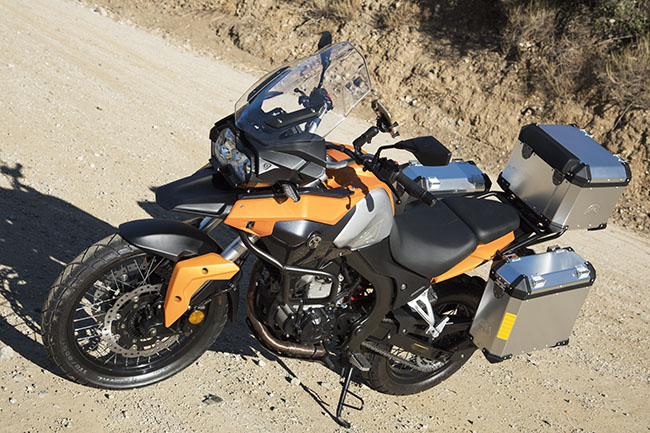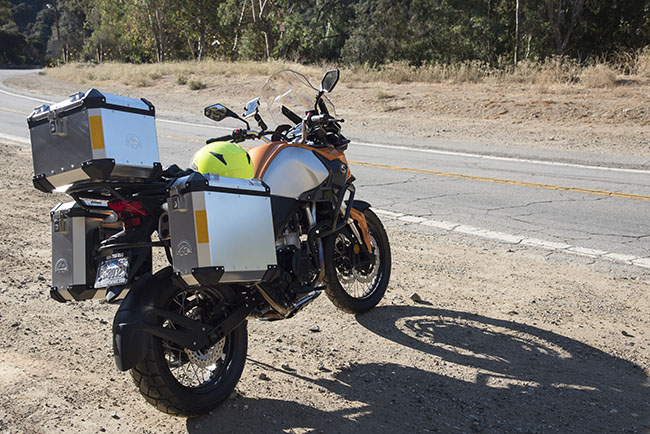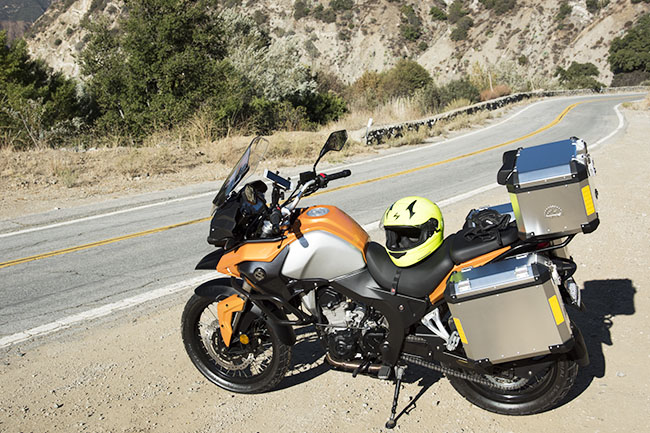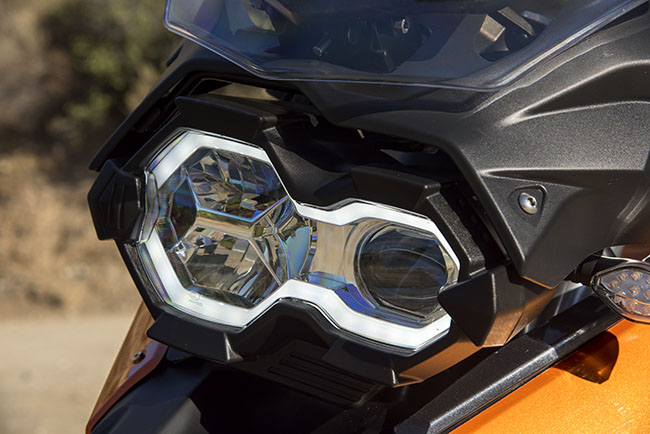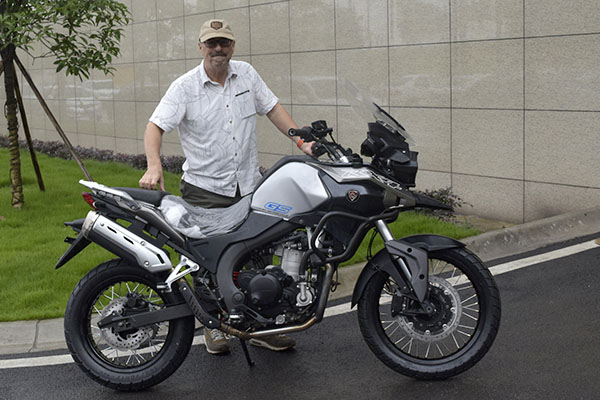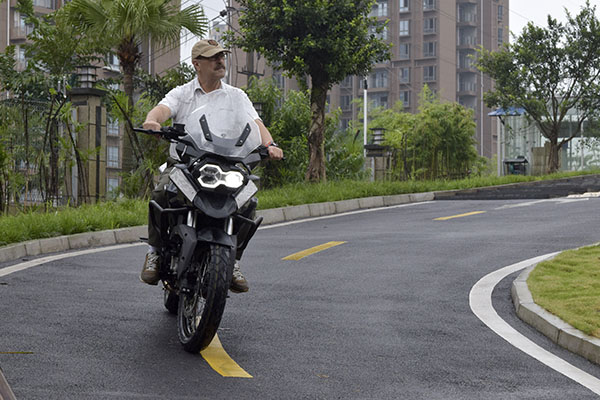Wow, where to begin? I thought I would do this in a single blog, but I quickly realized it’s going to take more than a few.
Joe Gresh thought it would be a good idea to do a comparison between the RX3 and the RX4, and since he’s the brains in this outfit (I’m the good looks), I started the photos for the comparo earlier today. There’s a lot to discuss, and I don’t want to try to cram it all into a “Gone With The Wind” single blog.
So, here we go with the first set of comparisons, and I guess as good a place to get started as any is with a shot from the rear of both bikes…

You’ll notice that my RX3 has the stock plastic luggage and the RX4 has the optional Tourfella aluminum luggage. The RX4 will come stock with the same plastic panniers as the RX3, but it will have a taller tailbox than the current RX3 design. The current RX3 tailbox won’t close with a full face helmet, but the taller stock plastic tailbox to be provided on the RX4 will. I’m hoping the 2019 RX3 will have the taller tailbox, too.
The Tourfella luggage is a great option. Both sets of luggage are lockable; the stock plastic bags use the bike’s ignition key. The Tourfella luggage has a separate key. The Tourfella bags have considerably more capacity than the stock plastic bags, and when I rode in Colombia with good buddies Juan and Carlos, my AKT RS3 (a carbureted RX3) had the Tourfella bags. You get a huge increase in capacity (which is nice), but the aluminum bags are wider and I’m guessing they are heavier. You’ll see a slight decrease in fuel economy and top speed with the larger bags on an RX3; I don’t know what they’ll do to both stats on an RX4.
I like the looks of both sets of luggage. I’m a guy who travels light, so the stock bags have been good enough for me on my adventure tours. One other minor disadvantage of the Tourfellas is they are wide. I scraped a taxi splitting lanes when debarking from a ferry ride down the Magdalena River in Colombia. Joe Gresh’s RX3 had the Tourfellas in China, and I watched him have the same problem a couple of times when splitting traffic there. But those big aluminum Tourfellas sure are nice. They are a high quality bit of kit, too. And like I said, you can carry a lot of stuff in those aluminum boxes.
Here are photos shot from the rear of each bike, starting with the new RX4…
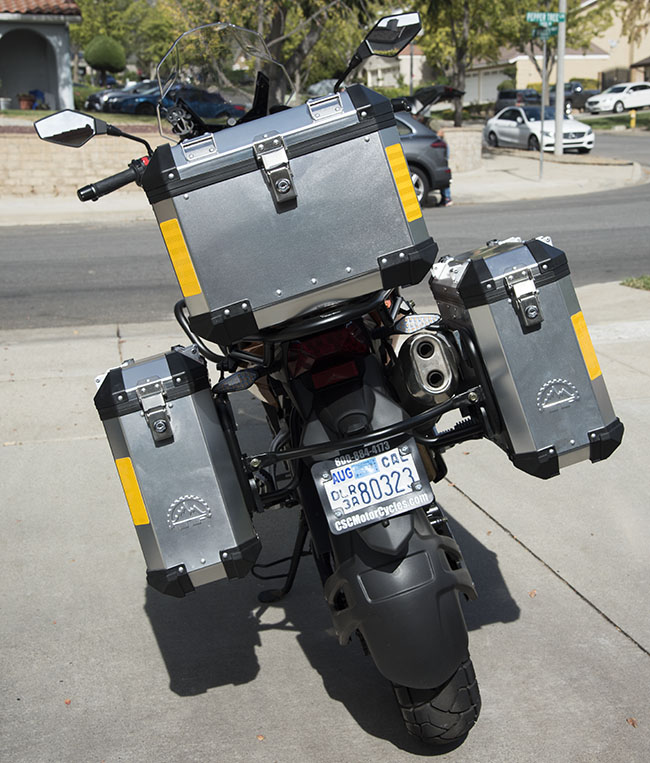
And here’s my RX3. It’s one of the very first delivered to the United States, and I’ve done some serious traveling with this motorcycle. It has the stock plastic luggage.
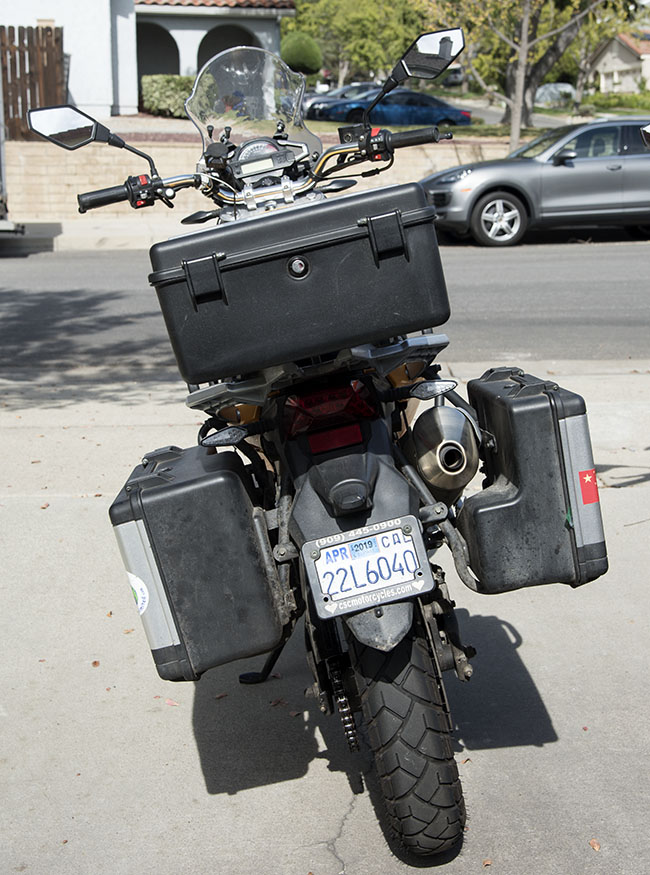
Next up are two photos of the exhaust outlets. On the RX4, the muffler has two openings, suggesting the bike is a twin (it’s not; it’s a single like the RX3).
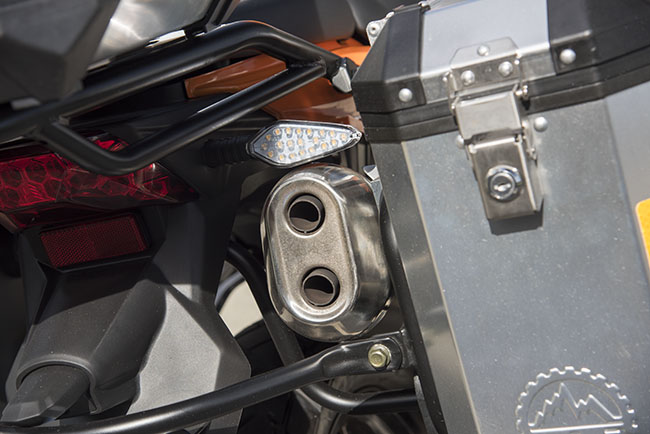
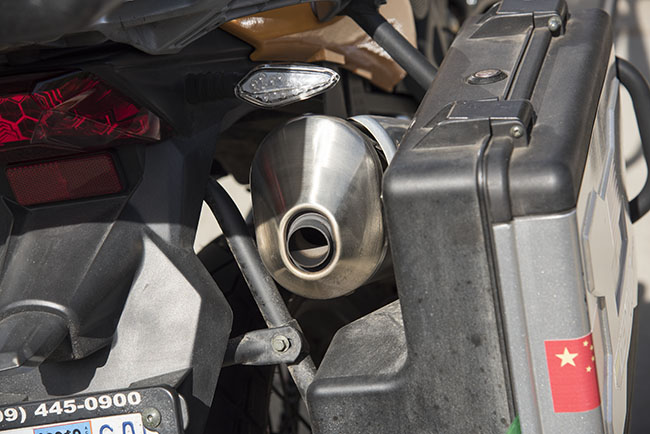
As I mentioned in my earlier blog on the RX4, the new bike sounds like the RX3, but you can tell it has a bigger and stronger engine. Both bikes sound almost as if they have a custom pipe. They are both actually a little bit louder than I’d like, but the sound is great. Good ExhaustNotes, I’d say.
Moving to the other end of both motorcycles, let’s take a look at the front brakes. The RX4 has twin-piston calipers and dual disks…
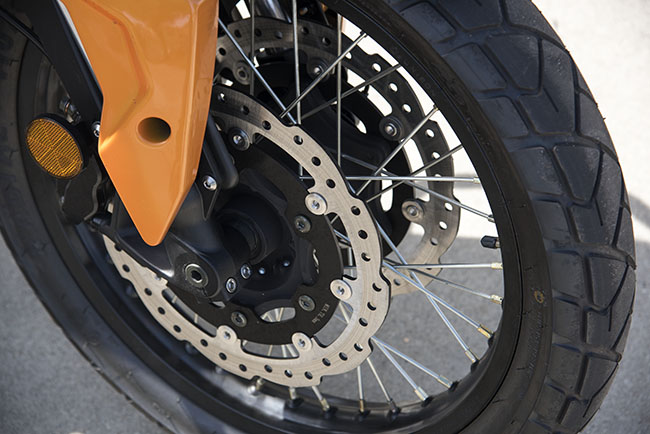
The RX3 has a single disk with a twin-piston caliper up front. My bike has the CSC larger diameter brake rotor. I think this is a worthwhile addition to the RX3, but I also think the stock RX3 brake is sufficient.
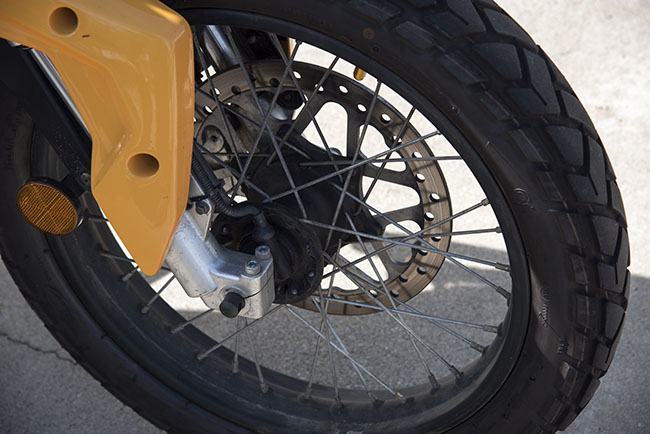
If you look closely at both of the above photos, you’ll see the two front wheels are different. I’ve already mentioned the RX4’s 19-inch front wheel (the RX3 has a standard 18-inch diameter front wheel, with a 19-inch wheel available as an accessory from CSC). What is also shown (but maybe is not so obvious) is that the RX4 has aluminum rims, while the RX3 has steel rims. I think that might be what makes the RX4 handle so well. Aluminum wheels mean less unsprung weight, and they also make a motorcycle handle more crisply.
The production RX4 motorcycles will have anti-skid braking, and unlike the the 2018 RX3 ABS, you’ll be able to turn the ABS off on the RX4. That’s something you dirt denizens asked for, and your voices have been heard. The RX4 will come standard with wire wheels (like you see in these photos), and cast aluminum wheels with tubeless tires will be an option. The RX4 wire wheels require tubes.
Here are couple of tangential thoughts intended for the wizards at Zongshen (they read ExhaustNotes, too, you know). I’d like you guys to consider adding the dual discs, the aluminum-rimmed wire wheels, and the switchable anti-skid braking on the 2019 RX3. That would make an already great motorcycle even better, I think.
Both the RX3 and the RX4 have Cheng Shin (CST) tires. They’re bigger on the RX4 (more on that in the next blog). These are good tires. They hook up well and they last a long time. I get about 6,000 miles out of a rear tire on my RX3, and as is the case with most motorcycles, the front tires last about twice as long as the rear tires.
Staying at the front of the motorcycle, let’s now take a look at the face of both bikes. This is my RX3…
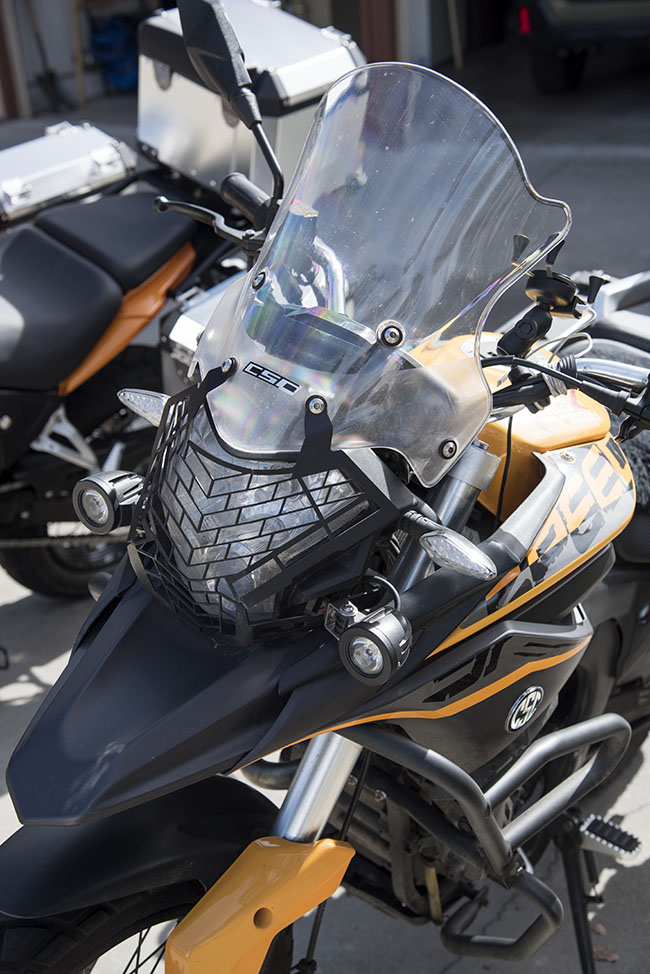
CSC changed the windshield and headlight design on the RX4. During my trips to Chongqing, I saw that Zongshen evaluated using the same RX3 windshield and headlight on the RX4. I thought keeping the windshield would have been a good idea, but hey, what do I know? The RX3 windshield has been universally praised by everyone who has ridden an RX3, including every magazine that tested the bike. It is a good design. It just works…there’s no turbulence, and it’s well below your line of sight. But like I said, who am I? I don’t make a million motorcycles a year. Zongshen does.
The RX3 headlight…well, that’s not the RX3’s strong point. Being charitable, I’d say it’s anemic. I don’t ride at night if I can avoid it, but I recognize that the stock headlight doesn’t light up the world the way I’d like it to. The spotlights you see on my bike are from AKT Motos in Colombia. I had them on the RS3 I rode there, and I liked them so much that my good buddy Enrique Vargas gave a pair to me when I left his beautiful country. CSC sells accessory spotlights, too, but I kept the AKT Motos lamps on my bike. I use the spotlights as headlights on my RX3 when I ride at night. Many folks who buy an RX3 put a brighter bulb in the headlight, and that works well. I have one that my good buddy TK gave to me, but I haven’t put it on my bike yet.
You’ll also notice the very cool headlight guard on my bike. That was another gift from Enrique in Colombia. CSC now sells a similar headlight guard. Mine is Colombian, and I’ve kept it instead of the CSC headlight guard because it was a gift and I like it.
Onward and upward…here’s the front end of the new RX4…
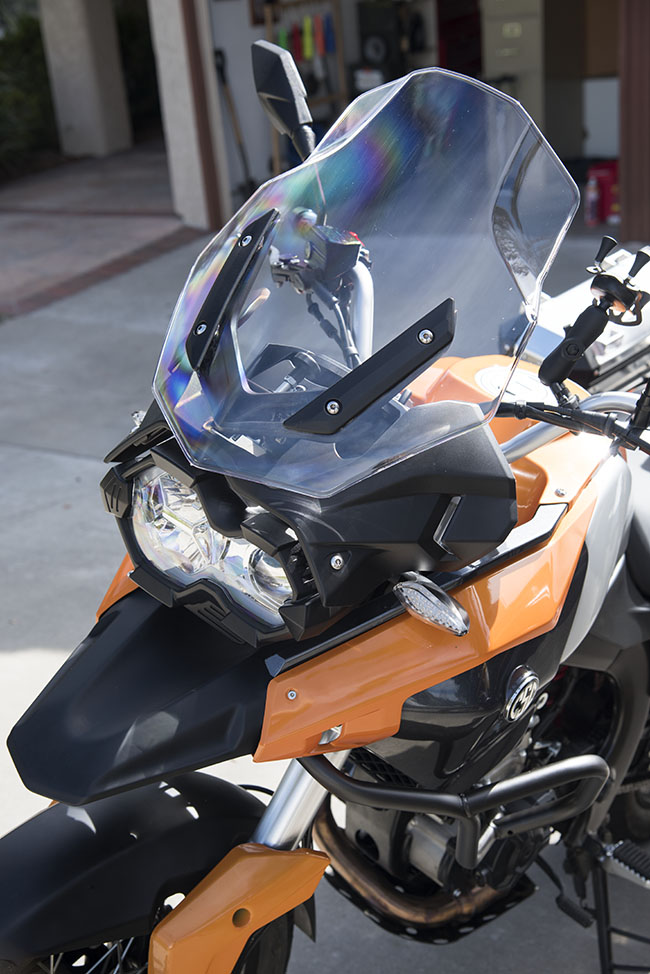
The RX4 headlight and windshield design are much changed from the RX3. Like I said above, CSC could have gone with a front end look identical to the RX4, but they opted instead for the new look. It’s grown on me. I would be okay with either one, and at first I recommended staying with the RX3 look because I feel it is an iconic Zongshen motorcycle face, but I like the new look, too. The new RX4 windshield is adjustable (the RX3 one is not). The headlight is a completely different design, and later tonight, I’m going to move both bikes onto the street to see how the headlight illumination patterns compare. I’ll try to get some photos so you can see the difference.
I’ll write more comparing the two bikes in the next several blogs. This blog is already longer than I intended, and there’s a lot more to cover in these comparisons.
You know it’s coming, folks. Like I always say: Stay tuned.

